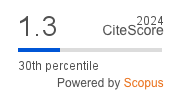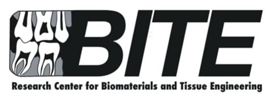Caspase-3/-9 as tongue cancer cell apoptosis target induced by ibuprofen
Downloads
Background: Tongue carcinoma is different from oral cancer in other areas because it has a high amount of cell growth, localized migration, and a higher rate of spreading to cervical lymphatic nodes. Therapeutic alternatives, particularly concerning recurrent malignancies, are notably constrained. Nevertheless, it is imperative to explore novel methodologies for refractory neoplasms, one of which may involve the application of ibuprofen. Purpose: The goal of this study was to look at how well caspase-3 and -9 break down proteins as possible targets for apoptosis in tongue cancer cells that were caused by ibuprofen. Methods: A controlled laboratory experiment employing a post-test-only design was executed. We used a colorimetric test for caspase-3 and -9 to check for the induction of apoptosis. The suppression of cellular invasion was verified through the Boyden chamber assay. Western blot analysis was utilized to identify the presence of caspase-3 and -9 proteins. The administered doses of ibuprofen were calibrated at 0, 5, 10, 25, 50, and 100 µg/mL. Data were subjected to analysis using two-way ANOVA followed by post-hoc Least Significant Different (LSD), with a significance threshold set at 95%. Results: It was established that ibuprofen at dosages ranging from 25 to 100 µg/mL significantly facilitated apoptosis in cells through an augmentation of the proteolytic activity of caspase-3 and -9. Notably, caspase-9 exhibited a superior proteolytic activity (1.85-fold) compared to caspase-3 (1.30-fold) (P = 0.038) at the 100 µg/mL concentration. The upregulation of caspase-3 and -9 proteins was observed in cells treated with ibuprofen. Ultimately, ibuprofen demonstrated an ability to inhibit the invasion of tongue carcinoma cells across various dosages. Conclusion: Ibuprofen has been shown to induce the proteolytic activities of caspase-3 and -9 in tongue carcinoma cells. However, the proteolytic activity of caspase-9 surpassed that of caspase-3, suggesting that targeting this protein may constitute a promising novel therapeutic strategy for this cancer variant.
Downloads
Tsai K-Y, Liao S-F, Chen K-L, Tang H-W, Huang H-Y. Effect of early interventions with manual lymphatic drainage and rehabilitation exercise on morbidity and lymphedema in patients with oral cavity cancer. Medicine (Baltimore). 2022; 101(42): e30910. doi: https://doi.org/10.1097/MD.0000000000030910
Supriatno, Yasmin T, Rizkiyani A, Akmalia MF. Ethanol extract of Borneo’s bajakah tampala toot (Spatholobus littoralis hassk) supresses the cell proliferation and chemotactic migration and induces apoptosis on a human oral tongue squamous cell carcinoma cell. J Int Dent Med Res. 2023; 16(2): 607–12. web: http://www.jidmr.com/journal/wp-content/uploads/2023/06/24-D23_2110_Supriatno_Indonesia.pdf
Zanoni DK, Montero PH, Migliacci JC, Shah JP, Wong RJ, Ganly I, Patel SG. Survival outcomes after treatment of cancer of the oral cavity (1985–2015). Oral Oncol. 2019; 90: 115–21. doi: https://doi.org/10.1016/j.oraloncology.2019.02.001
Li R, Xiao L, Gong T, Liu J, Li Y, Zhou X, Li Y, Zheng X. Role of oral microbiome in oral oncogenesis, tumor progression, and metastasis. Mol Oral Microbiol. 2023; 38(1): 9–22. doi: https://doi.org/10.1111/omi.12403
Bombardo M, Malagola E, Chen R, Rudnicka A, Graf R, Sonda S. Ibuprofen and diclofenac treatments reduce proliferation of pancreatic acinar cells upon inflammatory injury and mitogenic stimulation. Br J Pharmacol. 2018; 175(2): 335–47. doi: https://doi.org/10.1111/bph.13867
Bushra R, Aslam N. An overview of clinical pharmacology of ibuprofen. Oman Med J. 2010; 25(3): 155–61. doi: https://doi.org/10.5001/omj.2010.49
Banihani SA. Effect of ibuprofen on semen quality. Andrologia. 2019; 51(4): e13228. doi: https://doi.org/10.1111/and.13228
Jan-Roblero J, Cruz-Maya JA. Ibuprofen: toxicology and biodegradation of an emerging contaminant. Molecules. 2023; 28(5): 2097. doi: https://doi.org/10.3390/molecules28052097
Ha M-W, Paek S-M. Recent advances in the synthesis of ibuprofen and naproxen. Molecules. 2021; 26(16): 4792. doi: https://doi.org/10.3390/molecules26164792
Rainsford KD. Ibuprofen: from invention to an OTC therapeutic mainstay. Int J Clin Pract. 2013; 67(178): 9–20. doi: https://doi.org/10.1111/ijcp.12055
González-Barnadas A, Camps-Font O, Martín-Fatás P, Figueiredo R, Gay-Escoda C, Valmaseda-Castellón E. Efficacy and safety of selective COX-2 inhibitors for pain management after third molar removal: a meta-analysis of randomized clinical trials. Clin Oral Investig. 2020; 24(1): 79–96. doi: https://doi.org/10.1007/s00784-019-02910-3
Khwaja A, Throssell D. A critique of the UK NICE guidance for the detection and management of individuals with chronic kidney disease. Nephron Clin Pract. 2009; 113(3): c207–13. doi: https://doi.org/10.1159/000235240
Rayburn E, Ezell S, Zhang R. Recent advances in validating MDM2 as a cancer target. Anticancer Agents Med Chem. 2009; 9(8): 882–903. doi: https://doi.org/10.2174/187152009789124628
PDQ Supportive and Palliative Care Editorial Board. Oral complications of chemotherapy and head/neck radiation (PDQ®). PDQ cancer information summaries. National Cancer Institute (US); 2022. web: https://www.ncbi.nlm.nih.gov/books/NBK65881/
Sood S, Shiff SJ, Yang CS, Chen X. Selection of topically applied non-steroidal anti-inflammatory drugs for oral cancer chemoprevention. Oral Oncol. 2005; 41(6): 562–7. doi: https://doi.org/10.1016/j.oraloncology.2005.01.003
D’Arcy MS. Cell death: a review of the major forms of apoptosis, necrosis and autophagy. Cell Biol Int. 2019; 43(6): 582–92. doi: https://doi.org/10.1002/cbin.11137
Brentnall M, Rodriguez-Menocal L, De Guevara RL, Cepero E, Boise LH. Caspase-9, caspase-3 and caspase-7 have distinct roles during intrinsic apoptosis. BMC Cell Biol. 2013; 14(1): 32. doi: https://doi.org/10.1186/1471-2121-14-32
Supriatno, Medawati A, Yuletnawati SE. Expression of non-metastatic protein-23 and metastatic associated protein-1 as a molecular target therapy of an oral malignant Burkitt’s lymphoma induced by oligonucleotide p27 sense. J Int Dent Med Res. 2020; 13(2): 503–7. web: http://www.jidmr.com/journal/wp-content/uploads/2020/06/19-D20_1040_Supriatno_Indonesia.pdf
Supriatno, Irnawati D, Medawati A, Entin Yuletnawati S. Downregulation of MTA-1, complex of CDK2–cyclin E, and NF-kB expressions as a molecular target therapy of oral Burkitt’s lymphoma cells mediated by sense KIP-1 and antisense SKP-2. J Int Oral Heal. 2021; 13(5): 493. doi: https://doi.org/10.4103/JIOH.JIOH_350_20
Supriatno, Yuletnawati SE. Antitumor activity of chronic heart failure drug quinolinone derivate-vesnarinone on an oral malignant Burkitt’s lymphoma cell (Study on proliferation, chemotactic migration and cell apoptosis). J Int Dent Med Res. 2018; 11(3): 834–9. web: http://www.jidmr.com/journal/wp-content/uploads/2019/01/13_D18_608_Supriatno.pdf
Semlali A, Beji S, Ajala I, Rouabhia M. Effects of tetrahydrocannabinols on human oral cancer cell proliferation, apoptosis, autophagy, oxidative stress, and DNA damage. Arch Oral Biol. 2021; 129: 105200. doi: https://doi.org/10.1016/j.archoralbio.2021.105200
Mui KL, Chen CS, Assoian RK. The mechanical regulation of integrin–cadherin crosstalk organizes cells, signaling and forces. J Cell Sci. 2016; 129(6): 1093–100. doi: https://doi.org/10.1242/jcs.183699
Supriatno, Yuletnawati SE. Up-regulation of s-phase kinase associated protein-2 antisense induces cell growth and migration chemotactic suppression and apoptosis in a malignant oral Burkitt’s lymphoma cells. Int J Sci Res. 2015; 4(12): 1639–44. doi: https://doi.org/10.21275/v4i12.NOV152307
Ghanghas P, Jain S, Rana C, Sanyal SN. Chemopreventive action of non-steroidal anti-inflammatory drugs on the inflammatory pathways in colon cancer. Biomed Pharmacother. 2016; 78: 239–47. doi: https://doi.org/10.1016/j.biopha.2016.01.024
Akrami H, Aminzadeh S, Fallahi H. Inhibitory effect of ibuprofen on tumor survival and angiogenesis in gastric cancer cell. Tumor Biol. 2015; 36(5): 3237–43. doi: https://doi.org/10.1007/s13277-014-2952-3
Takahashi T, Saikawa Y, Kitagawa Y. Gastric cancer: current status of diagnosis and treatment. Cancers (Basel). 2013; 5(1): 48–63. doi: https://doi.org/10.3390/cancers5010048
Sufiawati I, Piliang A, Ramamoorthy VR. Oral microbiota in oral cancer patients and healthy individuals: A scoping review. Dent J. 2022; 55(4): 186–93. doi: https://doi.org/10.20473/j.djmkg.v55.i4.p186-193
Movahedi M, Afsharfard A, Moradi A, Nasermoaddeli A, Khoshnevis J, Fattahi F, Akbari ME. Survival rate of gastric cancer in Iran. J Res Med Sci. 2009; 14(6): 367–73. pubmed: https://pubmed.ncbi.nlm.nih.gov/21772910/
Landskron G, De la Fuente M, Thuwajit P, Thuwajit C, Hermoso MA. Chronic inflammation and cytokines in the tumor microenvironment. J Immunol Res. 2014; 2014: 1–19. doi: https://doi.org/10.1155/2014/149185
Pramono C. The use of surgical template for palatal fistula repair in cleft palate using tongue flap: 3 case report. Int J Surg Case Rep. 2023; 111: 108808. doi: https://doi.org/10.1016/j.ijscr.2023.108808
Azuma M, Harada K, Supriatno, Tamatani T, Motegi K, Ashida Y, Sato M. Potentiation of induction of apoptosis by sequential treatment with cisplatin followed by 5-fluorouracil in human oral cancer cells. Int J Oncol. 2004; 24(6): 1449–55. web: https://pubmed.ncbi.nlm.nih.gov/15138587/
Copyright (c) 2025 Dental Journal

This work is licensed under a Creative Commons Attribution-ShareAlike 4.0 International License.
- Every manuscript submitted to must observe the policy and terms set by the Dental Journal (Majalah Kedokteran Gigi).
- Publication rights to manuscript content published by the Dental Journal (Majalah Kedokteran Gigi) is owned by the journal with the consent and approval of the author(s) concerned.
- Full texts of electronically published manuscripts can be accessed free of charge and used according to the license shown below.
- The Dental Journal (Majalah Kedokteran Gigi) is licensed under a Creative Commons Attribution-ShareAlike 4.0 International License

















